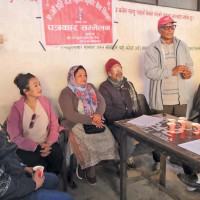- Thursday, 22 January 2026
How Long Will Remittance Sustain Nepal's Economy?
In recent months, Nepal has witnessed a substantial increase in remittance inflows, surpassing Rs. 100 billion per month consistently. This surge in remittances has led to notable improvements in both the external and internal sectors of the economy.
There has been a notable increase in foreign currency reserves, improving surpluses in the balance of payments and current accounts due to the flow of remittances. Higher reserves provide a cushion against external shocks and bolster confidence in the economy.
Despite persistent challenges in revenue mobilisation, the surge in remittance inflows offers a glimmer of hope. Efforts to optimise revenue streams must align with leveraging remittances as a vital economic lifeline.
There has been a gradual decline in bank interest rates alongside an increase in available liquidity in the banking sector. This trend suggests improved liquidity conditions, potentially encouraging borrowing for investment and stimulating economic activities. These factors contribute to overall economic stability and growth prospects.
Despite the positive developments in remittance inflows and other economic indicators, challenges persist in revenue mobilisation. The government's ability to generate revenue to meet recurrent expenditures remains constrained, indicating fiscal challenges.
Record high remittances
According to the latest report of the Nepal Rastra Bank (NRB), Nepal has received remittance of Rs. 839 billion in the first seven months of the current fiscal year 2023/24. This is 21.6 per cent higher than remittances received in the same period last fiscal year.
In US dollar terms, remittance inflows increased by 19.1 per cent to 6.31 billion in the review period, compared to an increase of 16.4 per cent in the same period of the previous year.
The report showed that remittance of Rs. 106 billion have been received in a single month from mid-January to mid-February 2024 of the current fiscal year. The country received Rs. 112.62 billion in the month of Kartik (mid-October to mid-November 2023).
However, Nepal received a record high remittance of around Rs. 137 billion in a single month of Ashoj (from September 18 to October 17). The country received remittances of around Rs. 116.09 billion in the month of September.
The inflow of remittances in the past 10 years has increased, except during the global COVID-19 pandemic in the fiscal year 2019/20.
In the fiscal year 2013/14, Nepal received remittance of Rs. 543.29 billion, while in the fiscal year 2022/23, it reached Rs. 1,220.55 billion. The country received remittance of Rs. 961.05 billion in the fiscal year 2020/21 and Rs. 1,007.3 billion in the fiscal year 2021/22 billion. Over the past 10 years, the average annual growth of remittance inflows has been 11.13 per cent.
The growing use of digitalisation, the increasing trend of sending remittance through formal channels, and the rise in the number of migrant workers are the main reasons behind the increase in remittance inflows in the country, said economists.
The foreign workers are sending money to Nepal when the dollar has strengthened, which also contributed to the increase in remittance inflow.
Nepal receives a substantial amount of remittance from its citizens working abroad, particularly in countries like India, Malaysia, Qatar, Saudi Arabia, the United Arab Emirates, and other Gulf countries, as well as the United States and the United Kingdom.
The government of Nepal, along with the NRB, monitors remittance inflows and implements policies to encourage the flow of remittances through formal channels, thereby ensuring transparency and facilitating economic development.
Remittance and economy
Remittances contribute significantly to Nepal's GDP, help alleviate poverty, and support household consumption and investment. According to data from the Nepal Rastra (NRB), remittance inflow has been a crucial source of foreign exchange for the country, often exceeding earnings from exports of goods and services.
The significant growth in remittance inflows has emerged as a crucial lifeline for the national economy. It provides essential support for sustaining economic activities, particularly in a context where productivity levels have not met desired targets.
Remittances can generate a positive effect on the economy through various channels such as savings, investment, growth, consumption, poverty, and income distribution.
The growth of remittance inflows is a major factor in setting records for foreign currency reserves in the country. Four major sectors—export, foreign direct investment, foreign aid, and tourism—are the main sources of foreign currency earnings. But the exports have remained low, while the FDI has slightly improved. In this context, remittance plays a significant role in making the position of foreign currency reserves strong.
In the meantime, remittances contribute to Nepal's foreign exchange reserves, bolstering the country's ability to manage imports, stabilise currency fluctuations, and meet external debt obligations.
At the community level, remittances create multiplier effects in the domestic economy, producing employment opportunities and encouraging new economic and social infrastructure and services, especially where effective structures and institutions have been set up to pool and direct remittances.
At a time when the country's productivity has not increased, a significant increment in remittance inflows gives a lifeline to the national economy along with improving indicators of the external sector of the economy, said economist Dr. Chandra Mani Adhikari.
Stating that the increase in remittance inflows will help the national economy in the short term, he said that instead of being happy with the current increase in remittance flows, the government should pay attention to increasing productivity and augmenting exports as a source of foreign exchange earnings.
The improvement in remittance contributed to liquidity in banking, and banks have started to reduce the interest rate gradually over the months.
Remittance inflows stimulate domestic consumption and investment. Families often spend remittance money on goods and services, contributing to local businesses and economic growth. Additionally, remittances may be invested in housing, land, or small businesses, further driving economic activity.
Historic foreign currency reserves
According to the NRB, the foreign currency reserves reached an all-time high of Rs. 1,844.94 billion during the first seven months of the current fiscal year.
Foreign currency reserves increased by about Rs. 28.37 billion during a single month (mid-January to mid-February 2024). The foreign currency reserves amounted to Rs. 1,816.57 billion in mid-January 2023.
The share of Indian currency in total reserves stood at 22.6 per cent in mid-February 2024.
Based on the imports of seven months in 2023/24, the foreign exchange reserves of the banking sector are sufficient to cover the prospective merchandise imports of 14.7 months, and merchandise and services imports of 12.3 months.
Last year, there was a reserve of foreign currency that could be sufficient only for 7 months, but it reached an all-time high and is enough for over a year.
Meanwhile, there has been further improvement in the current account and Balance of Payments (BOP) during the review period. The BOP remained at a surplus of Rs. 297.72 billion in the review period, compared to a surplus of Rs. 128.55 billion in the same period of the previous year.
Similarly, the current account remained at a surplus of Rs. 161.69 billion in the review period against a deficit of Rs. 40.16 billion in the same period of the previous year.
In US dollar terms, the current account registered a surplus of 1.22 billion in the review period against a deficit of 314.6 million in the same period last year.
Increasing reliance on remittances
Remittances play an important role as a financial source to offset the gradually increasing trade deficit in Nepal.
The remittance income in the service sector has been increasing year after year. In the fiscal year 2022/23, the ratio of remittance to the gross domestic product stood at 22.70 per cent.
But the overall service sector has not been able to cover the trade deficit.
It seems that adequate efforts have been made by the government of Nepal through the five-year plan, annual budget, and various policy arrangements to ensure that the remittances can be invested in the productive sector and help to achieve sustainable economic development by creating more jobs.
But because of the heavy reliance on remittances in the management of the external sector, even modest fluctuations in remittance flows could have a major impact on various sectors of the economy.
The remittance has contributed significantly to meeting basic needs, reducing poverty, increasing the literacy rate, and building and developing infrastructure in the fields of agriculture, tourism, energy, and sports.
Above 50 per cent of households in the country depend on remittance income, which plays a vital role in reducing poverty and income inequality.
But there is no need to be happier seeing the increase in remittance. It is unfortunate to have depended only on remittances for more than two decades, failing to create employment opportunities and expand domestic production.
Brain drain overlooked
Despite the positive impact of remittances on Nepal's economy, there are also concerns about over-reliance on remittances, brain drain, and social implications such as the disintegration of families due to the migration of workers.
The migration of skilled workers can lead to a "brain drain" in the sending countries, as they lose valuable human capital. Emigration of skilled workers can exacerbate skill shortages in key sectors of the economy.
Around 100,000–150,000 people go abroad for study, taking 'No Objection Certificate’ annually, 90 per cent of whom would not return to Nepal.
Limited job opportunities and high unemployment rates in some countries push individuals to seek work abroad. They often send a significant portion of their earnings back home to support their families financially.
Other countries, including the United States of America, Japan, Australia, and even China and India, are gaining brains, but we are draining brains. So, it should be our concern for the self-reliant, sustainable economic development of the country.
The government should create opportunities for migrant workers to return home and utilise their skills, knowledge, and capital in productive sectors. Currently, some foreign returnees from South Korea have started to operate various industries and agriculture farms in Nepal by utilising their skills and capital.
Lately, the number of people going abroad for foreign employment has also increased.
According to the Department of Foreign Employment, about 471,000 people went abroad during the first eight months of the current fiscal year 2023/24.
An average of 2,000 Nepalis go abroad every day in search of work in Nepal. The number of people seeking foreign employment has increased this year compared to pre-COVID-19 times.
Around 66,000 people went abroad for jobs within a single month of Falgun, while around 71,000 people went in the Mangsir of the current
fiscal year.
The United Arab Emirates (UAE), Saudi Arabia, Qatar, and Malaysia are the major labour destinations for Nepalis. In the last month, about 18,700 people went to the UAE, 13,200 to Saudi Arabia, 11,4000 to Qatar, and 8400 to Malaysia.
Although the number of people going to work abroad decreased after the COVID-19 pandemic, it has started increasing since last year.
Way forward
Dependency on remittance income makes Nepal vulnerable to fluctuations in global economic conditions, currency exchange rates, and the policies of host countries.
Efforts have been made to expand domestic production and generate employment through various means, including skill development programmes, promoting entrepreneurship, and creating opportunities for employment within the country.
Nepal could focus on diversifying its economy by promoting sectors beyond remittance-dependent industries like agriculture, tourism, hydropower, and manufacturing.
Nepal should create a conducive environment for FDI by implementing investor-friendly policies, reducing bureaucratic hurdles, and ensuring legal and regulatory transparency. The FDI inflows can help create jobs, transfer technology, and spur innovation, complementing efforts to reduce reliance on remittances.
"If we delay further to retain youth in the country and mobilise them in production, the country's economy cannot improve, and it will fall into crisis anytime when the remittance drops for any reason," former finance secretary Rameshore Khanal said.
“The remittance is not a long-term source for national economic consolidation. But it is essential to properly use the remittances received from migrant workers for the foundation of the national economy by investing them in the productive sector," he said.
It is necessary to look for alternatives to remittance to reduce the dependence on remittance, as the inflow of remittance might be affected at any time when our labour destination countries stop hiring workers.
For example, Malaysia has been gradually reducing the number of workers.
There is no alternative to retaining youth in the country for overall development. The government should not further delay creating an environment to bring youth who are working abroad to Nepal and utilise their knowledge, skills, and capital for the country's development.
(Kafle is a journalist at The Rising Nepal.)






-original-thumb.jpg)










